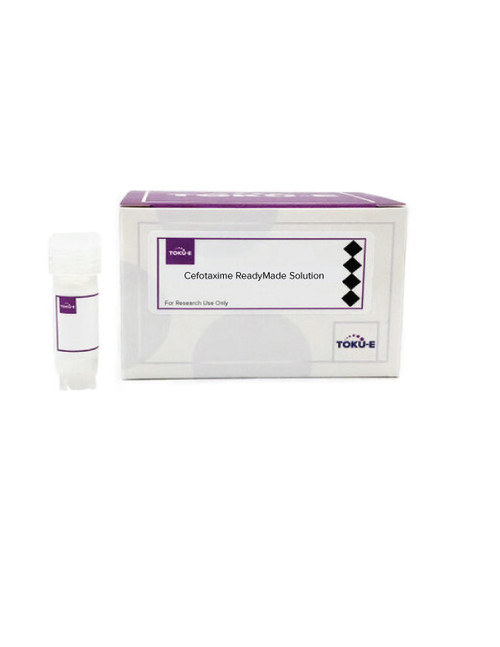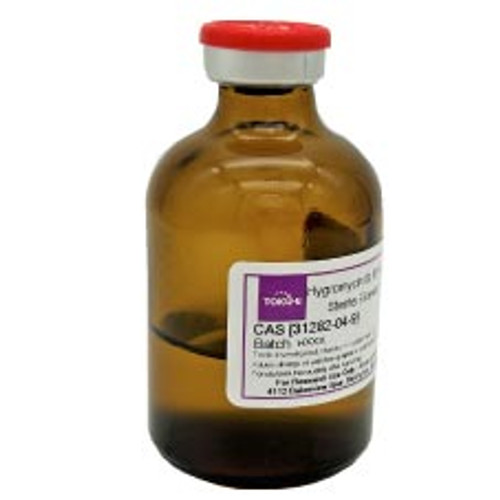Mitomycin ReadyMadeTM solution is provided as a sterile-filtered solution of Mitomycin C formulated in DMSO at a concentration of 10 mg/ml. It has been filter-sterilized using a 0.22 μm filter. The product has anti-cancer properties and inhibits proliferation of various cell types in vitro. It can be used as a maintenence antibiotic in stem cell research.
Mitomycin C is a natural product isolated from Streptomyces spp. It was the first recognized bioreductive alkylating agent and is a bacteriocidal methylazirinopyrroloindoledione antineoplastic antibiotic.
We also offer:
- Mitomycin C (M009)
| Molecular Formula | C15H18N4O5 |
| Mechanism of Action | Mitomycin C is generally nonreactive in its natural oxidized state, and is activated in vivo via reduction, generating oxygen radicals which produce crosslinks in DNA by alkylation. The Mitomycin C itself does not react with DNA. Rather, upon reduction of the quinone, a transformation ensues, and the aziridine ring opens to produce the unstable vinylogous quinone methide 2, which has high alkylating reactivity. High content of guanine and cytosine favor this cross-linking reaction, which is the basis of its lethal effect in vivo. |
| Spectrum | Mitomycin C is broad-spectrum, effective for Gram-negative and Gram-positive bacteria. |
| Eukaryotic Cell Culture Applications | Mitomycin can inhibit cell proliferation of both human and murine embryonic fibroblast cells (MEFs), when used at 0.2 - 20 µg/ml. These treated cells can then be used as an adherent feeder layer in long-term culture assays for growth of pluripotent stem cells. Feeder cells release growth factors into the medium and serve as the substrate to which target cells can attach.
Recommended concentration for cell culture is 0.2- 20 µg/ml. |
| Cancer Applications | Mitomycin has antineoplastic activity similar to that of the alkylating agents. It inhibits DNA synthesis via cross-linking, degrades preformed DNA, and causes nuclear lysis.
Mitomycin has high efficiency and specificity for CpG sequences, but only 5% of guanines in the mammalian genome are present in CpG islands. However, retaining this cross-linking ability but altering the sequence specificity could allow the design of more efficacious anti-tumor properties of this agent (Tomasz, 1995). An in vivo rat bladder tumor model, Mitomycin C (400 uM) prevents intravesical tumor growth in a concentration- and time-dependent manner (Jankun et al, 2014). |
| References |
Geargopoulos M, Vass C, Vatanparast Z, Wolfsberger A and Georgopoulos A (2002) Activity of dissolved Mitomycin C after different methods of long-term storage. J. Glaucoma 11(1):17-20 PMID 11821684 Jankun J, Keck RW, Selman SH (2013) Epigallocatechin-3-gallate prevents tumor cell implantation/growth in an experimental rat bladder tumor model. Int J Oncol. 2014 44(1):147-152. PMID 24220494 Iyer VN and Szybalski W (1964) Mitomycins and porfiromycin: Chemial mechanism of activation and cross-linking of DNA. Science 145(3627):55-58 PMID 14162693 Mao Y, Varoglu M and Sherman DH (1999) Molecular characterization and analysis of the biosynthetic gene cluster for the antitumor antibiotic Mitomycin C from Streptomyces Iavendulae NRRL 2564. Chem. and Biology 6(4): 251–263 PMID 10099135 Renault J, Baron M; Mailliet P (1981). Heterocyclic quinones.2.Quinoxaline-5,6-(and 5-8)-diones - Potential antitumoral agents. Eur. J. Med. Chem. 16(6):545–550 |








